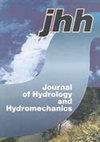The soil moisture regime and groundwater recharge in aged forests in the Sand Ridge region of Hungary after a decline in the groundwater level: an experimental case study
IF 2.4
4区 环境科学与生态学
Q3 WATER RESOURCES
引用次数: 2
Abstract
Abstract The decline in groundwater levels is a cause of concern in many regions of the world, including the Sand Ridge of Hungary. The causes of the regional depletion range from rising air temperatures, changes in precipitation, domestic and agricultural groundwater use and past amelioration and recent afforestation, including the effects of drilling for crude oil exploration. The relations between the decline, the soil water regime and groundwater recharge under existing aged forests remained unclear thus far. Based on our monitoring of groundwater and soil moisture we aim to clarify this interplay in a new experimental site on the hilltop of the Sand Ridge. We compared three land-uses: a 41-year-old black locust (Robinia Pseudoacacia) offshoot forest, an 83-year-old first generation black pine (Pinus nigra) forest, and a grassland control site. The observed differences in the soil moisture profiles and dynamics were connected to the use of water by the given type of vegetation. We indicated a connection between the disruption of the groundwater recharge and the loss of contact of the rooting system of the forests with the deepening of the unconfined aquifer. Even if the aged forests could locally contribute to the decline, we conclude that the decline at the hilltop site that may be more strongly driven by other regional factors.地下水水位下降后,匈牙利沙岭地区老森林土壤水分状况和地下水补给:一个实验案例研究
在世界上许多地区,包括匈牙利的沙岭,地下水位的下降引起了人们的关注。区域枯竭的原因包括气温上升、降水变化、家庭和农业地下水的使用以及过去的改良和最近的造林,包括为原油勘探而钻井的影响。现存古林退化、土壤水分状况和地下水补给之间的关系目前尚不清楚。基于我们对地下水和土壤水分的监测,我们的目标是在沙脊山顶的一个新的实验地点阐明这种相互作用。我们比较了三种土地利用方式:有41年历史的刺槐(Robinia Pseudoacacia)枝林、有83年历史的第一代黑松(Pinus nigra)林和草地控制点。观察到的土壤水分剖面和动态的差异与给定类型的植被对水的利用有关。我们指出,随着无承压含水层的加深,地下水补给的中断与森林根系失去联系之间存在联系。我们认为,即使森林的老化可能是局部减少的原因,山顶遗址的减少可能更强烈地受到其他区域因素的驱动。
本文章由计算机程序翻译,如有差异,请以英文原文为准。
求助全文
约1分钟内获得全文
求助全文
来源期刊
CiteScore
4.20
自引率
5.30%
发文量
30
审稿时长
>12 weeks
期刊介绍:
JOURNAL OF HYDROLOGY AND HYDROMECHANICS is an international open access journal for the basic disciplines of water sciences. The scope of hydrology is limited to biohydrology, catchment hydrology and vadose zone hydrology, primarily of temperate zone. The hydromechanics covers theoretical, experimental and computational hydraulics and fluid mechanics in various fields, two- and multiphase flows, including non-Newtonian flow, and new frontiers in hydraulics. The journal is published quarterly in English. The types of contribution include: research and review articles, short communications and technical notes. The articles have been thoroughly peer reviewed by international specialists and promoted to researchers working in the same field.

 求助内容:
求助内容: 应助结果提醒方式:
应助结果提醒方式:


